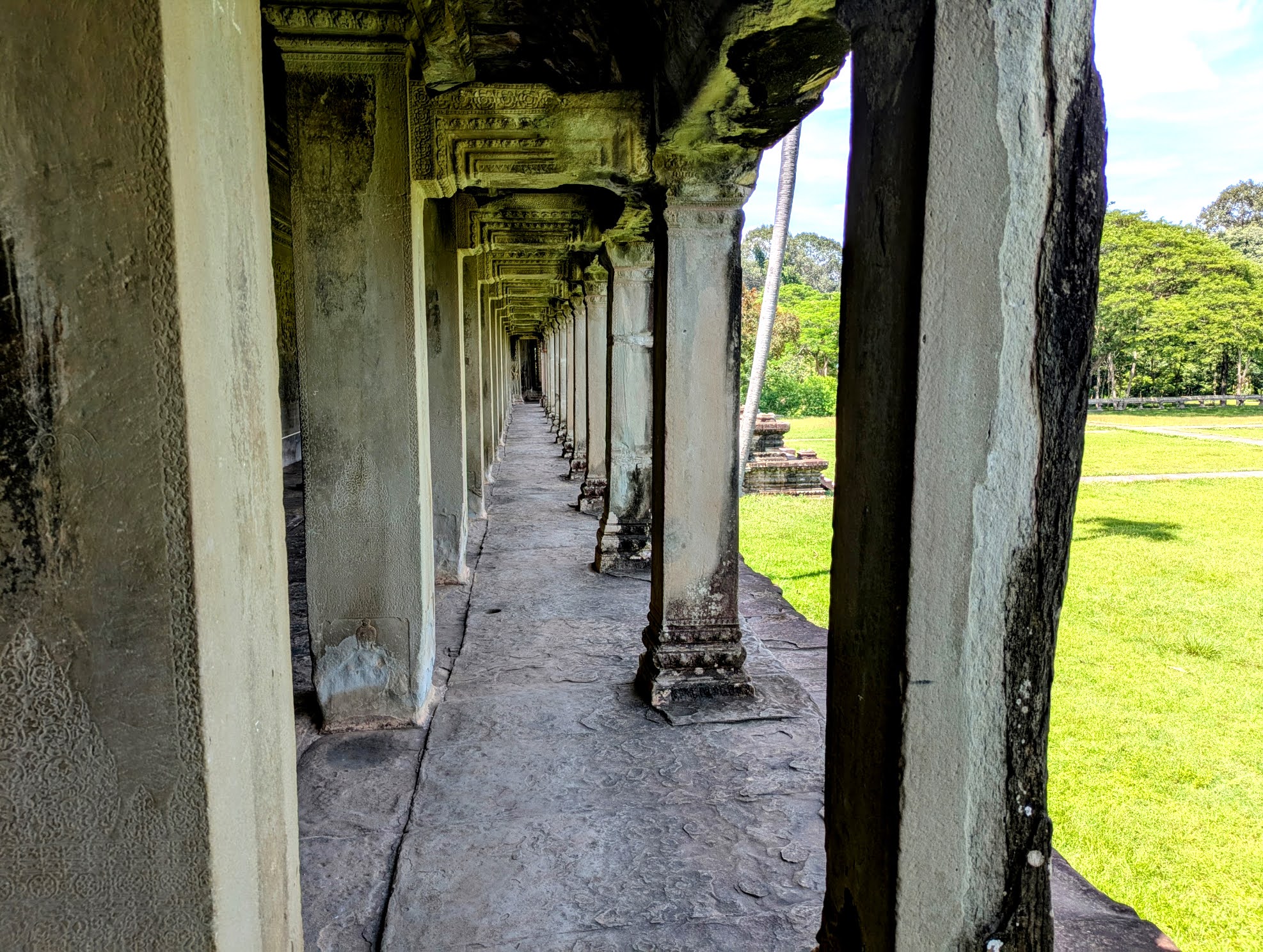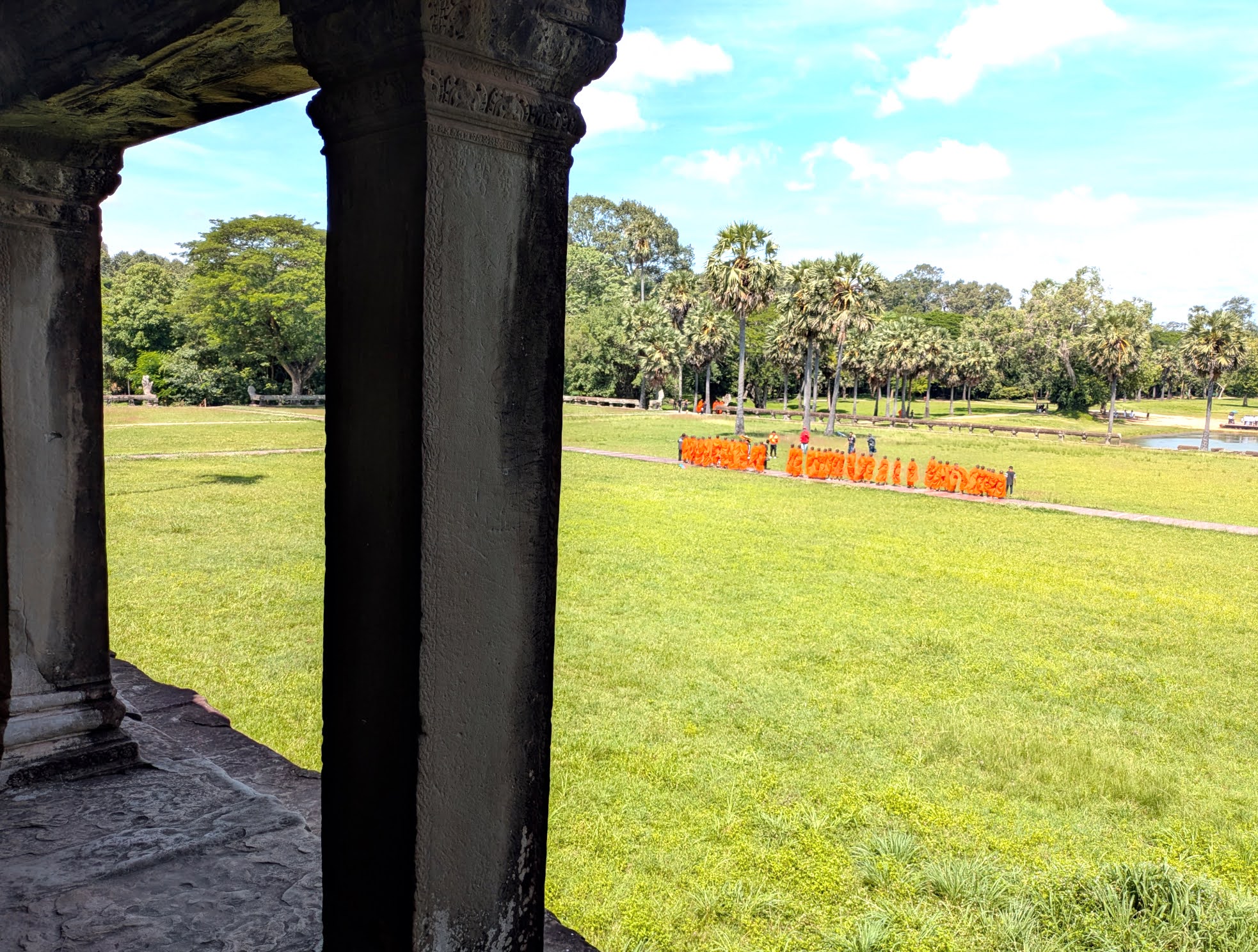There’s something transformative about passing through the gates here in Cambodia. Whether it’s the ancient causeway leading to Angkor Thom, flanked by rows of stone guardians, or the simple wooden entrance to a village home, these thresholds seem to invite a shift in perspective, an opening of the mind and heart to what lies ahead.
You truly can’t know the scale and sheer presence of the temples at Angkor until you’re there, standing before them. We started at the largest and most famous, Angkor Wat, the temple that graces Cambodia’s flag and stands as the heart of what was once the mighty Khmer Empire. From the 9th to 15th centuries, this civilization created architectural marvels that still take your breath away today.
The crowds were so sparse that I often found myself alone as I toured the long galleries lined with intricate bas-reliefs. These stone walls tell stories of cosmic battles, royal processions, and daily life from centuries past — masterful carvings that connect us directly to the artists and storytellers of the Khmer people. Looking up at the temple’s soaring spires, I felt that profound sense of scale that only comes from standing in the presence of something both ancient and eternal.

As I sat soaking it all in, a large group of young monks walked by, many smiling and saying hello in English. They descended the steps and continued along their way across the grounds, their saffron robes a living reminder that this isn’t just a monument to the past — it’s part of Cambodia’s breathing, evolving culture. In that moment, I was reminded of just how many encounters with the sublime I’ve experienced here.

The cultural exchange continues beyond the temples. Yesterday we ate lunch on a deck surrounded by water, the only Westerners to be seen, and the proud owner came by to thank us for coming and asked us to return. My carnivorous companions have been delighting in dishes like frog stuffed with minced pork and spices (feels like Cambodia’s answer to a turducken) while I’ve had no trouble finding delicious vegetarian options that showcase the incredible flavors of Khmer cuisine.
These moments of genuine hospitality remind me that travel at its best is about more than seeing sights. It’s about human connection across cultures.
Yesterday also brought an especially meaningful visit to a small village where my school’s students have built relationships over many years. We came to pay respects to Man Men, a master of the chapei, a traditional two-stringed guitar, who performed in our very own amphitheater in 2018 and recently passed away.
Man Men’s story embodies both the fragility and resilience of cultural heritage. After the devastating period of the Khmer Rouge, when so much of Cambodia’s artistic tradition was lost, he was among the few remaining masters of his instrument. Organizations like Cambodian Living Arts helped connect him with new audiences and provided support for him to teach younger generations, ensuring his musical gifts wouldn’t disappear with him. When he visited our school, students were mesmerized by his skill and warmth: a master musician sharing his art across continents.
His daughter and family continue this vital work of preserving and sharing their musical heritage with the world. Meeting them, seeing their dedication to keeping these traditions alive, was deeply moving. Man Men’s legacy lives on not just in the music, but in his generous spirit and the connections he fostered.
I can’t quite believe that tomorrow marks a week since we left on this journey. There’s much more to come, but what’s already happened will stay with me for a lifetime.
Perhaps the most powerful lesson emerging from these experiences is how much difference we can make — even when we’re not wealthy or influential — by simply finding ways to make the world a little better. The students and teachers who’ve traveled here over the years, building relationships in this village. The organizations working to preserve cultural traditions. The individual connections formed across language barriers and cultural differences.
Together, over time, these small acts of respect, curiosity, and genuine engagement create something much larger than any single gesture. They build bridges not unlike those ancient stone causeways leading to Angkor’s gates, and they connect us across time, distance, and difference.
As I prepare for whatever transformative threshold awaits tomorrow, I’m grateful for the reminder that the most meaningful journeys happen not just through physical spaces, but through the openings we create in our hearts and minds for connection with others.
